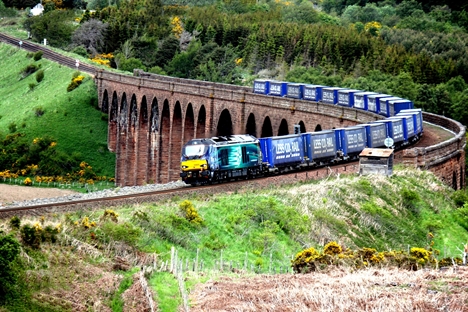10.07.17
Reducing congestion
Source: RTM Jun/Jul 17
New figures show rail freight is far better at reducing congestion than previously thought, writes Philippa Edmunds, Freight on Rail manager at the Campaign for Better Transport (CBT).
The latest figures from the Daventry Intermodal Rail Freight Terminal reveal it has removed 64 million miles of lorry journeys from UK roads in the last year alone, almost three times more than previously thought. These detailed calculations, supplied to us by W H Malcolm, which runs the Daventry Terminal, confirm what CBT has long argued: that the best way to reduce road congestion, collisions and pollution is integrated rail and road planning, not adding ever more lanes to motorways.
Furthermore, the analysis highlights the role that road/rail transfer points have in expanding rail freight traffic. Strategic Rail Freight Interchanges (SRFIs) like Daventry are important economic generators and show the way the private sector is investing in and supporting rail freight.
SRFIs are an intrinsic element of shifting more freight to rail, as they enable rail to compete with HGVs by reducing the transhipment costs between the modes as recognised by the government in its National Networks National Policy Statement of 2014. CBT is now calling for the government to follow the private sector’s lead and support rail freight by upgrading the existing network and setting affordable charges to enable rail to remove even more lorries from our congested roads.
SRFIs offer ancillary services such as warehousing and container-handling to reduce the transhipment costs between road and rail, and make rail freight more financially viable. Daventry Intermodal Rail Freight Terminal employs more than 5,000 people and is forecast to employ up to 9,000 when its new terminal opens. Other new rail freight interchanges are coming on stream designed to create a larger network of rail freight hubs to provide a catalyst for significant new business between the UK, mainland Europe and beyond. Four Ashes SRFI, near Wolverhampton, is currently going through the planning system and Doncaster I Port has a SRFI opening later this year.
The fact that each lorry removed from a congested part of the Strategic Road Network is equivalent to removing up to four standard cars shows the congestion benefits of rail freight. This is because lorries take up more space, need longer braking distances and are slower to manoeuvre than cars.

Road and rail complement each other so it is important that each mode plays to its strengths. Consumer rail freight, which has consistently grown this year, is well-placed to offer the long-distance trunk haul. In fact, government figures show the potential for modal shift to rail as the largest HGVs (5+ axles) make far more longer distance journeys than the smaller lorries. A quarter of all their trips are over 300km so some of this traffic should be captive to rail if there is enough rail capacity.
Recent DfT-sponsored research, carried out by consultants MTRU for CBT, found that upgrading existing rail lines running parallel to strategic motorway routes would help reduce road congestion and improve productivity.
The research found that upgrading existing rail lines on certain strategic corridors, which run parallel to the motorway routes and are currently nearing full capacity, would allow large numbers of these lorry loads to be transferred to rail. In particular, it showed that on the A14 out of Felixstowe, the A34 out of Southampton and the M6 it is possible to improve road conditions without needing to add more road capacity. This would help road congestion because of the extra road space taken by lorries. For example, transferring 2,000 lorry loads a day to rail would be the equivalent of taking 8,000 cars off the road.
Sending more goods by rail has the potential to dramatically reduce road congestion, road collisions, CO2 and NOx emissions, so we are highlighting these points to the government as it plans for the next Network Rail control period and the ORR review of rail freight access charges.
FOR MORE INFORMATION
W: www.freightonrail.org.uk